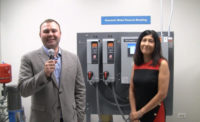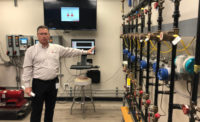MORTON GROVE, Ill. — Class at the Xylem Bell & Gossett Little Red Schoolhouse is back in session, and you’d be hard pressed to find a square inch of space inside and out that isn’t prepared to interactively educate.
Since its inception in 1954, more than 62,000 engineers, contractors, and other hydronic HVAC and plumbing professionals have been educated at the Little Red Schoolhouse. Bell & Gossett offers a wide range of seminars and is accredited by the International Association for Continuing Education and Training (IACET).
The Little Red Schoolhouse has traditionally differentiated itself from other educational facilities in the industry by emphasizing a systems-based concept of teaching rather than focusing on product features and benefits. Courses are intimate, averaging around 40 or fewer individuals per class, and are offered free of charge.
“With a mix of people attending the Little Red Schoolhouse, we want to make sure we are effectively teaching all our students,” said Mike Licastro, training and education manager, commercial building services and HVAC, Bell & Gossett. “Whether it’s customers, manufacturer’s representatives, engineers, technicians, or contractors, our goal is that the training provides a knowledge base that makes them better equipped to perform their daily job duties related to hydronic and steam product application and system design.”
Little red renovations
An extensive remodeling project has transformed the Little Red Schoolhouse into an interactive learning environment, where professionals are able to see and touch components, so they can understand how the entire HVAC system works. The facility features functional displays of equipment for a variety of commercial and industrial applications, including variable speed controller technology, plumbing products, service and maintenance, and more.
“We wanted to make sure that no matter where you were in the Little Red Schoolhouse, there was a learning opportunity readily available,” Licastro said.
The new dedicated service and maintenance area features 10 carts that will have various Bell & Gossett products, providing attendees opportunities to learn how to disassemble, assemble, and troubleshoot numerous types of equipment.
“One of the highlights of our service and maintenance class is that we’re now able to teach students how to disassemble a gasketed plate-and-frame heat exchanger,” Licastro said. “This is something that we see out in the industry that a lot of people are very fearful of. They want to know what to do and how to do it. We’re happy to now have it as part of our curriculum.”
The plumbing display products area was built to showcase the latest water-based technologies and opportunities, including variable speed pumps, hot water circulation systems, and more.
“We can watch pumps stage on and off or change speeds accordingly to match the loads necessary in specific applications,” Licastro said. “We also have the ability to generate and store hot water and demonstrate different ways to balance these systems.”
The HVAC area showcases pressure-dependent control belts and sensorless variable speed controls.
“Pressure-dependent control belts allow us to stabilize loads under part-load conditions, which helps maintain system efficiency,” Licastro said.
A steam system design area features a live, operational electric steam boiler; glass shell tube heat exchangers; and more.
“The steam boiler allows us to generate low-pressure steam on-site,” Licastro said. “We also have different technology in terms of pressure reduction and temperature regulation, which allows us to experiment with pressure changes and temperature set points.”
A condensing boiler section generates hot water for the plumbing displays and allows students to track the water’s journey throughout the facility.
“We have a buffer tank that holds water and circulating pumps that direct it in various directions,” Licastro said. “From ECM pumps to small circulators, we’re aiming to provide all the different types of pumps that are currently available — offering students experience with exactly what they’ll be designing and utilizing in the field.”
Every innovation utilized at the Little Red Schoolhouse is specifically designed to ensure the next generation is adequately prepared to provide comfort services today and tomorrow, Licastro said.
“I have a 22-year-old son, and he's the type of individual that if you show him how to do something, he is locked down and ready to go,” said Licastro. “There are a lot of people like my son out there waiting to find their paths, and I believe that the HVAC industry is a key path for many of them. If we get them here, and allow them to see that they can be creative and use their influence and excitement to make something happen, the sky is the limit. That's exactly what we're trying to do here at the Little Red Schoolhouse.”
Mechanical room
New technology figures prominently not only in the redesigned training center but into the building’s own mechanical room, which features a new air-handling unit, ECMs, a chiller, and more.
“We all know that we have to have air changes to overcome indoor air quality issues, so we installed an air-handling unit with the right amount of airflow based on the number of people we’ll be hosting,” Licastro said. “We're using the latest ECM technology with integrated variable speed controls as well as an integrated control system. This allows us to monitor outside air temperature and determine whether we need to be in heating or cooling mode.”
A new small-volume-type chiller features an integrated variable speed, sensorless control system.
“We know through years of experience that when a chiller is online, it likes to stay online for at least seven minutes, so you have to have enough water in the system to do that,” Licastro said. “Well, we didn't have that in the past. We've now got a chilled water buffer tank that provides additional volume for our system. When our chiller does come on, it can maintain at least that seven minutes of runtime. If I have 40 students plus instructors, which creates a pretty good heat load, that chiller’s going to be running a long time.”
While many things have changed, a few have stayed the same, including a radiant system that’s served the facility since it’s opening more than 60 years ago.
“Our radiant heat system, which utilizes steel pipe, was installed in 1954. It’s still working today,” Licastro said. “Three hydronic, in-floor zones utilize three small circulators to heat the training facility, and that radiant system is still doing a darn good job.”
Engineering testimonials
As dozens attended the grand reopening, several visitors shared their thoughts on what the Little Red Schoolhouse means to them.
Jim Burns, president, Mulcahy Co., called the grand reopening a very special day.
“I came out of the University of Minnesota in 1986 after spending five years learning how to become an engineer,” he said. “I worked for two weeks in the field, and then I came to the Little Red Schoolhouse for three months to attend training. In those three months, I actually learned hydronics and steam systems. I didn't learn those skills in engineering school. I couldn't learn them anywhere else. Those skills are not something you learn easily in a university or in any other setting. Plus, they don't charge for this; the school is free, right? I’m very excited about this opportunity going forward.”
David Everhart, president, Bornquist Inc., recalls the time he spent at the Little Red Schoolhouse more than 30 years ago.
“I came out as a graduate of the Little Red Schoolhouse’s summer program back in 1988,” he said. “The history of this place is significant to the industry because more than 60,000 people have come through this program. That’s a huge number. Some of the geniuses of the industry — names like Gil Carlson — are embedded here. Bell & Gossett is building upon all of that past history of design and equipment excellence and preparing it for the industry’s next generation.”
For more information or a full training schedule, visit www.bellgossett.com.








